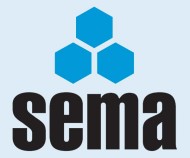 The first question this month is looking for information on conducting a picking and packing operation in an area below racking. The second query asks if there is a requirement by law for end of rack protection.
The first question this month is looking for information on conducting a picking and packing operation in an area below racking. The second query asks if there is a requirement by law for end of rack protection.
Guidance on a Pick and Pack operation
Q. I have a customer who is looking to start up a pick and pack operation in their warehouse under the racking, do you have any information or guidance regarding this.
A. I do not believe there is any specific SEMA guidance regarding pick and pack operations below racking and I am not sure if your concern is people working in fork truck areas or working below the supported goods in the racking.
Each operation is slightly different and a full risk assessment of the proposed operation should be carried out. Any identified risks should be reduced to an acceptable level to ensure the safe operation of the warehouse.
This may include specific training or systems of work.
The HSE and SEMA documents offer general advice such as the paragraph from HSE document HSG76 below:-
This document ‘Warehousing and storage. A guide to health and safety.’ can be downloaded free from the HSE website and should provide some useful information.
408 where employees work in conjunction with trucks, additional precautions should be adopted:
Write out the safe system of work. Drivers should not operate if a pedestrian is in their immediate area. Employees should be instructed to stand clear of trucks that are lifting or lowering loads and to use separate walkways where provided. People should be reminded of the dangers of entering areas such as those behind the truck where they may not be fully visible to the driver and also that the tail-swing, particularly on counterbalanced trucks, is very pronounced.
Consider fitting flashing warning beacons to trucks.
The use of reverse audible warning on lift trucks may be beneficial in some applications but you need to assess the effects of background noise, nuisance levels, and confusion on direction or source, particularly if more than one vehicle is being used in the area.
Site-specific control measures are particularly important in racking aisles.
409 See chapter Vehicles in and around the warehouse, particularly paragraphs 507–508.’
The Law and racking end protection
Q. Is it a requirement by law that end of racking has protection.
A. The legal requirements are:-
To comply with the requirements of:-
‘The Workplace Health Safety and Welfare Regulations’ or
‘The Provision and Use of Work Equipment Regulations (PUWER) 1998’
Following the guidance from HSE, BS-EN Codes, SEMA Codes and other published safety information is one way of complying with the legal requirements.
This is made clear in the ‘HSG76, Warehouse and storage, A guide to health and safety’ document which states:-
‘This guidance is issued by the Health and Safety Executive. Following the guidance is not compulsory and you are free to take other action. But if you do follow the guidance you will normally be doing enough to comply with the law. Health and safety inspectors seek to secure compliance with the law and may refer to this guidance as illustrating good practice.’
The guidance
The guidance from HSE, BS-EN and SEMA all recommend the use of Corner Protection as below:-
1. HSG76, Warehouse and storage. A guide to health and safety racking protection
Corner uprights in a run of racking are especially at risk and should be suitably provided with a protective device in a conspicuous colour.
2. BS EN 15629
In determining the minimum requirement for aisle and gangway widths, consideration shall be given to the provision of effective upright protection. The minimum locations protected should be:
a) uprights at the exposed ends of aisles and at passageways used for movement of trucks;
3. SEMA Users Code
Where necessary, steps should be taken to protect corner uprights from being struck by fork lift trucks and other vehicles. A first line of defence should be incorporated, such as renewable column guards or guide rails, which prevent the truck getting too close to the main racking structure.
Other options
It may be possible, in some cases, to justify not complying with the recommendations of HSE, BS-EN and SEMA. However, in the case of an incident involving an unprotected corner upright the HSE may request that the User clearly defines why they have chosen not to comply with the recommendations. If, for example, there are a number of other badly damaged corner uprights on the site, the company may have difficulty justifying why corner protectors were not used.
SEMA is delighted to be working with WLN on the storage Question and Answer Column which is published in WLN on a monthly basis. On the WLN website is a list of previously published columns which we hope you find useful.
SEMA Annual Safety Conference 2012
The 2012 SEMA Safety Conference has been scheduled for Thursday, 1 November, the venue will be the National Motorcycle Museum, Solihull. For full details enquiry@sema.org.uk
SEMA USERS Club
SEMA runs a USERS Club designed to be of benefit to purchasers and users of storage equipment. Members receive newsletters, access to specialised events and discounted rates on publications and codes of practice.
For more info, www.sema.org.uk




Comments are closed.